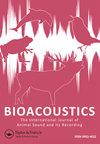雄性黄褐色猫头鹰(Strix aluco)个体呼叫的无监督识别使用声学信号的鲁棒测量
IF 2.1
4区 生物学
Q2 ZOOLOGY
Bioacoustics-The International Journal of Animal Sound and Its Recording
Pub Date : 2023-11-01
DOI:10.1080/09524622.2023.2270486
引用次数: 0
摘要
摘要褐鸮(Strix aluco)的声音个性已被广泛记载;然而,迄今为止,所有用于区分个体发声的统计工具都依赖于关于个体数量和身份的先验知识。在这项研究中,我们测试了四种无监督聚类算法的有效性,仅基于它们发声的声学特征来区分8只雄性黄褐色猫头鹰。我们还采用传统的基于边界的声信号测量和鲁棒的声信号测量来比较它们的效果。最后,我们评估了该方法在确定我们研究区域内记录的剩余雄性数量和分布方面的适用性。在四种无监督的方法中,有三种在区分八只雄性的叫声方面成功率很高。在所有情况下,使用稳健的测量获得了最佳结果。然而,当将分析扩展到剩余的未知男性记录时,最高的错误分类错误率使结果更难以解释。我们的研究提供了一个有用的工具来区分雄性茶色猫头鹰,当它们的呼叫记录是可用的。此外,这种方法可以扩展到其他夜行和吵闹的物种,代表了少数现有的基于声学特征的个体无监督分类方法之一。关键词:分层聚类、个体判别、鲁棒信号测量、监督聚类、无监督分类、声音个性致谢作者要感谢比萨大学工作小组(Tavolo Tecnico)对蒙特皮萨诺火灾的研究,他们致力于支持当地社区研究火灾的影响并促进烧伤地区的恢复。此外,我们要感谢托斯卡纳大区、比萨大学和生物系根据Tavolo Tecnico的建议为托马西尼·奥兰多提供博士奖学金。我们特别要感谢贝迪尼和佩特罗尼的财政支持。我们感谢Elisabetta Palagi为我们提供了Raven Pro软件。我们对Marta Berti、Giulia Cerritelli和Pietro Valente以及他们在实地数据收集方面的帮助表示感谢。此外,我们感谢Lorenzo Vanni和Luca Puglisi在数据收集方面的建议。最后,我们感谢John Kastelic在完善书面内容方面提供的宝贵帮助。作者贡献daniele Roccazzello和Orlando Tomassini一起进行了田野调查、声学和统计分析,并撰写了手稿。埃琳娜·贝尔纳迪尼为现场工作和声学分析做出了贡献。Marco Dragonetti指导了声学分析并编辑了手稿。亚历山德罗·马索罗建议进行统计分析,并编辑了手稿。Dimitri Giunchi监督和支持整个研究,并编辑了手稿。所有作者都认可了手稿的最终定稿。披露声明作者未报告潜在的利益冲突。补充材料本文的补充数据可在https://doi.org/10.1080/09524622.2023.2270486.Additional info网站上在线获取。本文章由计算机程序翻译,如有差异,请以英文原文为准。
Unsupervised discrimination of male Tawny owls ( Strix aluco ) individual calls using robust measurements of the acoustic signal
ABSTRACTVocal individuality has been widely documented in the Tawny owl (Strix aluco); however, all statistical tools employed thus far to discriminate individual vocalisations have relied on prior knowledge regarding number and identity of individuals. In this study, we tested the effectiveness of four unsupervised clustering algorithms in distinguishing among eight Tawny owl males, solely based on acoustic characteristics of their vocalisations. We also employed both traditional bound-based and robust measurements of acoustic signal to compare their efficacy. We finally evaluated the applicability of this method in identifying the number and distribution of the remaining males recorded in our study area. Three of the four unsupervised techniques had a high rate of success in discriminating among vocalisations of the eight males. In all cases, the best results were obtained using robust measurements. However, when extending the analysis to the remaining unknown males recorded, the highest rate of misclassification errors made results more difficult to interpret. Our study provided a useful tool to discriminate male Tawny owls when only their call recordings are available. Furthermore, this method could be extended to other nocturnal and vociferous species, representing one of the few existing approaches for unsupervised classification of individuals based on acoustic features.KEYWORDS: Hierarchical clusterindividual discriminationrobust signal measurementsunsupervised clusteringunsupervised classificationvocal individuality AcknowledgementsThe authors would like to thank the University of Pisa Working group (Tavolo Tecnico) for the Monte Pisano fires, which is dedicated to support the local community to study the effects of fires and to promote restoration of burnt areas. Moreover, we would like to thank Regione Toscana, the University of Pisa and the Department of Biology for funding the PhD scholarship for Tomassini Orlando following the recommendation provided by the Tavolo Tecnico. In particular, we would like to thank Gianni Bedini and Giulio Petroni for the financial support. Our thanks go to Elisabetta Palagi for providing us with the software Raven Pro. We extend our appreciation to Marta Berti, Giulia Cerritelli and Pietro Valente and for their help with data collection in the field. Additionally, we are grateful to Lorenzo Vanni and Luca Puglisi for their advice on data collection. Lastly, we are indebted to John Kastelic for his valuable assistance in refining the written content.Author contributionsDaniele Roccazzello, together with Orlando Tomassini, conducted the fieldwork, acoustical and statistical analyses, and wrote the manuscript. Elena Bernardini contributed to the fieldwork and acoustical analysis. Marco Dragonetti directed the acoustic analysis and edited the manuscript. Alessandro Massolo suggested statistical analyses and edited the manuscript. Dimitri Giunchi supervised and supported the overall study and also edited the manuscript. All the authors approved the final version of the manuscript.Disclosure statementNo potential conflict of interest was reported by the author(s).Supplementary materialSupplemental data for this article can be accessed online at https://doi.org/10.1080/09524622.2023.2270486.Additional informationFundingThis work was supported by Regione Toscana.
求助全文
通过发布文献求助,成功后即可免费获取论文全文。
去求助
来源期刊
CiteScore
4.50
自引率
0.00%
发文量
25
审稿时长
>12 weeks
期刊介绍:
Bioacoustics primarily publishes high-quality original research papers and reviews on sound communication in birds, mammals, amphibians, reptiles, fish, insects and other invertebrates, including the following topics :
-Communication and related behaviour-
Sound production-
Hearing-
Ontogeny and learning-
Bioacoustics in taxonomy and systematics-
Impacts of noise-
Bioacoustics in environmental monitoring-
Identification techniques and applications-
Recording and analysis-
Equipment and techniques-
Ultrasound and infrasound-
Underwater sound-
Bioacoustical sound structures, patterns, variation and repertoires

 求助内容:
求助内容: 应助结果提醒方式:
应助结果提醒方式:


